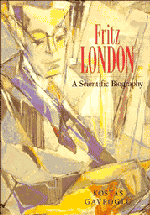Book contents
- Frontmatter
- Contents
- Preface
- Acknowledgements
- 1 From philosophy to physics
- 2 The years in Berlin and the beginnings of quantum chemistry
- 3 Oxford and superconductivity
- 4 Paris and superfluidity
- 5 Tying up loose ends: London in the USA
- Afterword: background leading to the microscopic theory of superconductivity by John Bardeen
- Publications by Fritz London
- Bibliography
- Index
1 - From philosophy to physics
Published online by Cambridge University Press: 12 January 2010
- Frontmatter
- Contents
- Preface
- Acknowledgements
- 1 From philosophy to physics
- 2 The years in Berlin and the beginnings of quantum chemistry
- 3 Oxford and superconductivity
- 4 Paris and superfluidity
- 5 Tying up loose ends: London in the USA
- Afterword: background leading to the microscopic theory of superconductivity by John Bardeen
- Publications by Fritz London
- Bibliography
- Index
Summary
Fritz London's first published paper in a professional journal was in philosophy. In 1921, the year he graduated from the University of Munich, whilst supervised by one of the most well-known phenomenologists, Alexander Pfänder, he wrote a thesis that dealt with deductive systems. It was among the very first attempts to investigate ideas about philosophy of science expressed by the founder of the phenomenological movement in philosophy, Edmund Husserl. It was a remarkable piece of work for someone who was 21 years old. In this work, London developed an antipositivist and antireductionist view. This is all the more surprising, given London's knowledge of and interest in science, and the appeal of positivism to many scientists. London also intervened in the controversy between Richard Tolman and Tatiana Ehrenfest-Afanassjewa about the possibility of finding physical laws by dimensional considerations alone. Many of the ideas elaborated by London in his later researches, including his insightful suggestions and discussions of macroscopic quantum phenomena, can, indeed, be traced back to these early philosophical wanderings.
Right after his graduation from the University he started teaching in the Gymnasium and, when he was ready to matriculate as a Gymnasium teacher, he resigned and went to Max Born, who was at the University of Göttingen, to work in philosophy. Born did his utmost to discourage him, but to no avail. Born's only hope to persuade the young London to do an actual calculation, like all others beginning a career in physics, was to convince him to go to Munich and to study with Arnold Sommerfeld.
- Type
- Chapter
- Information
- Fritz LondonA Scientific Biography, pp. 1 - 37Publisher: Cambridge University PressPrint publication year: 1995



